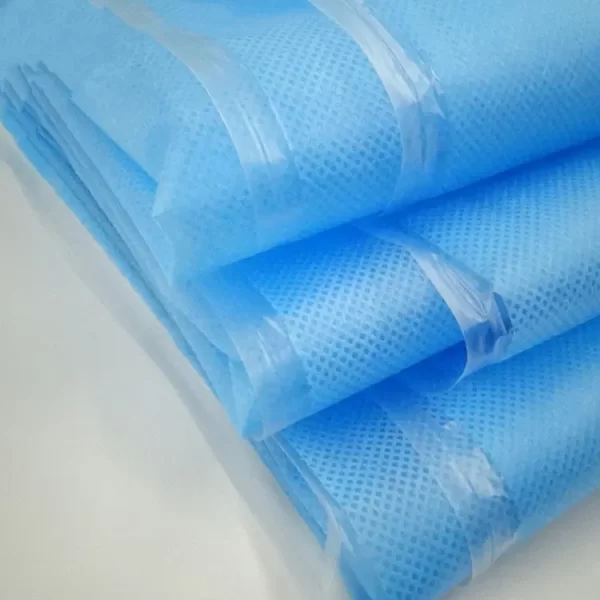Exploring the Properties and Applications of Laminated Nonwoven Fabrics
In the universe of textiles, laminated nonwoven fabrics are a marvel of engineering, creating a unique blend of flexibility, durability, and utility. Laminated nonwoven fabrics have been woven into the fabric of our lives, from the essential parts of our day-to-day living to advanced industrial applications. In this deep dive, we shall unravel the multifaceted characteristics of laminated nonwoven fabrics and their applications across various sectors.
The Intricacies of Laminated Nonwoven Fabrics
A marvel of textile engineering, laminated nonwoven fabrics stand as a testament to the ingenious blending of durability, flexibility, and purposefulness. These fabrics are an integral part of our everyday lives and are employed extensively across diverse industrial applications.
Contrary to traditional textiles created by weaving or knitting, nonwoven fabrics are fabricated by orienting fibers into sheets or webs. They are bonded together by friction, cohesion, or adhesion using methods such as spunbond, meltblown, needlepunch, and hydroentanglement. Lamination further enhances these fabrics by bonding layers of nonwoven fabric, often using heat and pressure. The resulting material benefits from both the original fabric’s properties and those of the laminating material.
Laminated nonwoven fabrics are often distinguished by their enhanced strength, stability, and resistance to moisture, bacteria, abrasion, and UV radiation, making them ideal for myriad applications.
Properties of Laminated Nonwoven Fabrics
1. Strength and Durability
Engineered for resilience, laminated nonwoven fabrics exhibit superior tensile strength, tear resistance, and durability. These properties make them suitable for applications that require materials capable of withstanding considerable stress without compromise on performance.
2. Breathability and Moisture Resistance
The breathability of laminated nonwoven fabrics allows for air and vapor passage, making them comfortable for use in clothing, bedding, and medical supplies. This feature, coupled with their resistance to moisture, makes them perfect for applications that require exposure to various environmental conditions.
3. Versatility
Laminated nonwoven fabrics are engineered to be versatile. They can be tailored to exhibit specific properties like fire resistance, UV protection, anti-bacterial characteristics, or enhanced softness, depending on the application for which they are intended.
4. Environmentally Friendly
Often manufactured from recyclable materials, many variants of laminated nonwoven fabrics are biodegradable. This environmental consideration adds another feather to the cap of these fabrics, making them a sustainable choice in an increasingly eco-conscious world.
Applications of Laminated Nonwoven Fabrics
The myriad applications of laminated nonwoven fabrics across diverse sectors can be attributed to their unique properties.
1. Medical and Healthcare
In the medical field, these fabrics have become indispensable. They are used in manufacturing surgical gowns, face masks, drapes, caps, gloves, shoe covers, and bandages. These fabrics provide a necessary barrier against fluids and microbes while also ensuring comfort and breathability. In addition, their sterilization-friendly nature makes them suitable for creating hygienic environments.
2. Automotive Industry
The automotive industry utilizes laminated nonwoven fabrics for creating car interiors such as seat covers, headliners, airbags, and insulation materials. The strength, durability, and resistance to abrasion offered by these fabrics make them the material of choice for such applications.
3. Geotextiles and Construction
Geotextiles extensively employ laminated nonwoven fabrics for applications like soil stabilization, drainage, and erosion control. These fabrics, when used for construction purposes, are employed for roofing, as house wraps, in insulation, and as vapor barriers. Their ability to withstand harsh environmental conditions makes them ideal for these industries.
4. Packaging and Consumer Goods
Laminated nonwoven fabrics find wide-ranging applications in the packaging industry. They are used in tea bags, wipes, shopping bags, and protective packaging. Their durability, lightness, and resistance to tear and abrasion make them the preferred choice for these applications.
5. Apparel and Furnishing
In the fashion and apparel industry, these fabrics are used in the production of various garments, especially outerwear, due to their weather resistance properties. The furnishing industry employs laminated nonwoven fabrics in products like mattresses, upholstery, curtains, and carpets due to their resilience, aesthetic flexibility, and comfort.
In conclusion, laminated nonwoven fabrics, characterized by their diverse properties and extensive applications, are an illustration of the remarkable advancements in textile technology. They have woven their way into various industries and hold an irreplaceable place in our day-to-day lives. As we continue to innovate and discover new enhancements for these fabrics, the potential for their applications is virtually limitless.
With an increasing emphasis on sustainability and high-performance materials, the future of laminated nonwoven fabrics looks bright and promising. To stay updated with the latest developments in the laminated nonwoven fabric industry, remember to subscribe to our newsletter and follow our social media handles. Together, we can explore the fascinating world of laminated nonwoven fabrics and continue to delve deeper into the intricacies of this remarkable material.
Please visit our website for more product details https://medposnonwoven.com/product-category/non-woven-fabrics/

